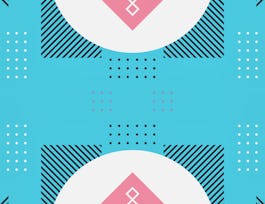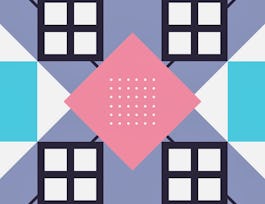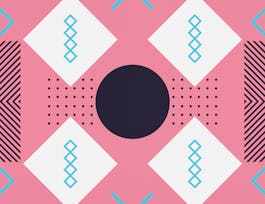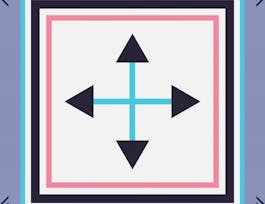This design-centric course examines the broad question of what an interface is and what role a designer plays in creating a user interface. Learning how to design and articulate meaning using color, type, and imagery is essential to making interfaces function clearly and seamlessly. Through a series of lectures and visual exercises, you will focus on the many individual elements and components that make up the skillset of an interface designer. By the end of this course, you will be able to describe the key formal elements of clear, consistent, and intuitive UI design, and apply your learned skills to the design of a static screen-based interface.


Visual Elements of User Interface Design
This course is part of UI / UX Design Specialization
Taught in English
Some content may not be translated

Instructor: Michael Worthington
242,406 already enrolled
Included with 
Course
(5,878 reviews)
97%
Skills you'll gain
Details to know

Add to your LinkedIn profile
2 quizzes
Course
(5,878 reviews)
97%
See how employees at top companies are mastering in-demand skills

Build your subject-matter expertise
- Learn new concepts from industry experts
- Gain a foundational understanding of a subject or tool
- Develop job-relevant skills with hands-on projects
- Earn a shareable career certificate


Earn a career certificate
Add this credential to your LinkedIn profile, resume, or CV
Share it on social media and in your performance review

There are 5 modules in this course
Welcome! In this first module I will summarize the assignments and expectations of this course, as well as the UI/UX Design Specialization.
What's included
5 videos9 readings
In this first week we will look at some basic broad concepts and contexts for user interfaces, looking at examples both on and off-screen. We will look at basic principles of interaction theory, discuss the relationship between UI and UX, and examine the relationship between coding and designing. We will discuss the roles of functionality and aesthetics in interface design and outline a "form-first" philosophy to user interface design. This week will focus on background information and terminology and will give you the context and vocabulary necessary before you start making great interfaces!
What's included
9 videos2 readings2 quizzes1 discussion prompt
This week we are going to examine the various formal elements that make up an interface. We’ll start out with the larger questions of content, context and audience that frame any UI/UX project. In other words: What is it? Who is it for? And, where does it live? And we’ll look at the big picture of overall design direction, what is often referred to as “look and feel”. From there we’ll go into detail of how the basic components of how visual design works in the context of interface design: language, shape, color, imagery, typography, and icons. These areas will be the formal building blocks you will use to create the more complex visual structure of a screen-based user interface.
What's included
8 videos1 reading1 peer review
This week we are going to take our static interface elements and begin to think about how a user interacts with them. In other words, how to bring these elements a stage closer to having a life on the screen. We’ll be looking at navigational conventions, such as menus, buttons, and icons in different states. Our focus will move from what the graphic interface looks like, to include how it works and how it responds to the user. By adding interactivity to our static designs, the idea is to think more deeply about the role the designer plays in shaping a user’s interactive experience.
What's included
8 videos4 readings1 peer review
This week we are going to take our individual interface components and see what happens when we try to put them together into a more complex structure. We’ll be looking at how to get our components to work harmoniously as a family, figuring out how hierarchy works in the interface, and discussing conventions and expectations of contemporary interface design. We’ll also be examining how to navigate to different screens and how to build visual relationships between different kinds of content within a single site. Finally, we’ll be discussing different platforms, how to create variable content for different screen sizes, and looking at how to organize complex bodies of content into user-friendly structures.
What's included
7 videos2 readings1 peer review
Instructor

Offered by
Recommended if you're interested in Music and Art

California Institute of the Arts

California Institute of the Arts

California Institute of the Arts

California Institute of the Arts
Why people choose Coursera for their career




Learner reviews
Showing 3 of 5878
5,878 reviews
- 5 stars
77.11%
- 4 stars
18.38%
- 3 stars
2.78%
- 2 stars
0.69%
- 1 star
1.01%

Open new doors with Coursera Plus
Unlimited access to 7,000+ world-class courses, hands-on projects, and job-ready certificate programs - all included in your subscription
Advance your career with an online degree
Earn a degree from world-class universities - 100% online
Join over 3,400 global companies that choose Coursera for Business
Upskill your employees to excel in the digital economy
Frequently asked questions
Since this is a graphic design course, to complete the assignments you will need access to a desktop or laptop computer with the appropriate software installed. You can't really do graphic design work properly on a smartphone or tablet. In addition you will need a beginner level knowledge of graphic layout software. Adobe CC software is recommended for these courses, but alternatives are out there. Software will be reviewed in greater detail in the first week of the course, but is not taught in this course.
Access to lectures and assignments depends on your type of enrollment. If you take a course in audit mode, you will be able to see most course materials for free. To access graded assignments and to earn a Certificate, you will need to purchase the Certificate experience, during or after your audit. If you don't see the audit option:
The course may not offer an audit option. You can try a Free Trial instead, or apply for Financial Aid.
The course may offer 'Full Course, No Certificate' instead. This option lets you see all course materials, submit required assessments, and get a final grade. This also means that you will not be able to purchase a Certificate experience.
When you enroll in the course, you get access to all of the courses in the Specialization, and you earn a certificate when you complete the work. Your electronic Certificate will be added to your Accomplishments page - from there, you can print your Certificate or add it to your LinkedIn profile. If you only want to read and view the course content, you can audit the course for free.

